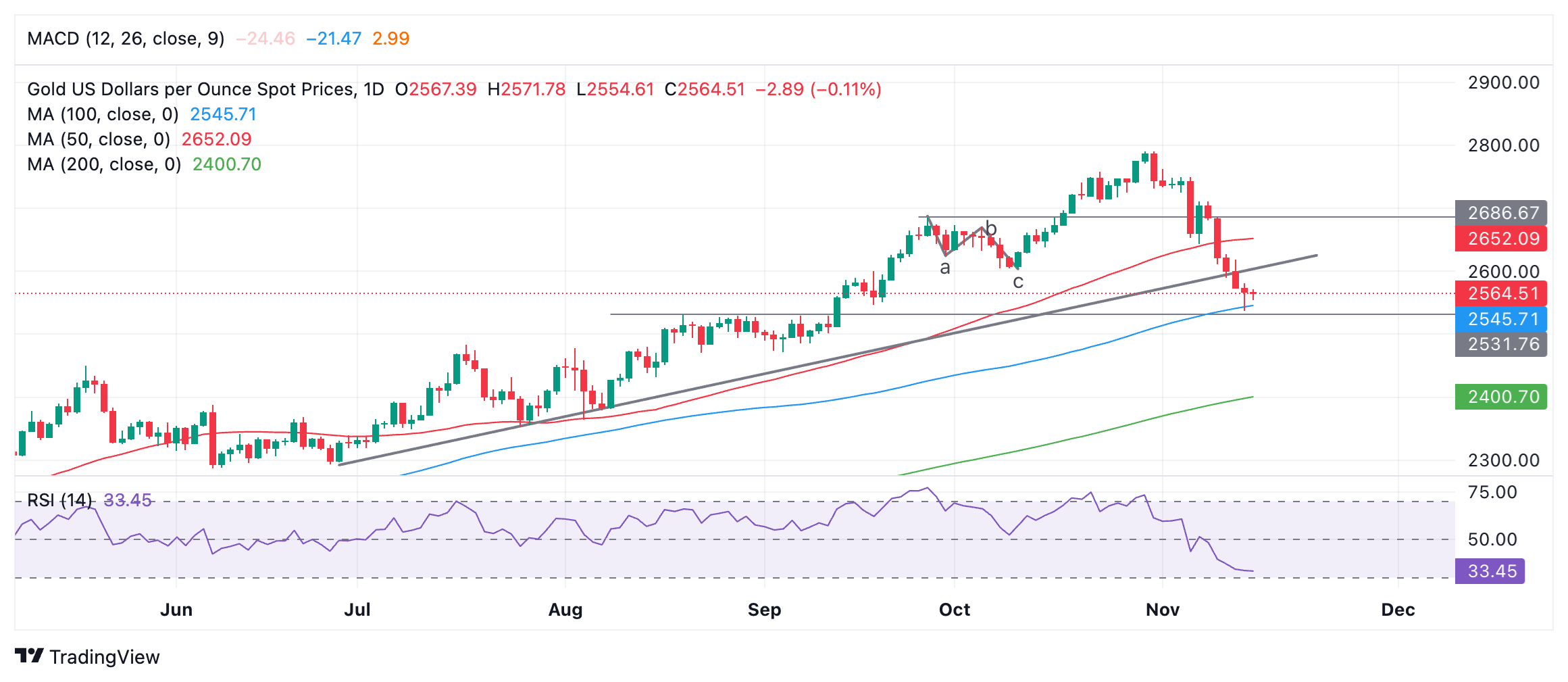- Gold bounces off technical support helped by the US Dollar peaking and pulling back.
- The precious metal faces headwinds from the outlook for US interest rates and Trumponomy.
- The US economy is in “remarkably good shape,” according to Fed Chairman Powell, boosting the USD and weighing on Gold.
Gold (XAU/USD) is trading flat on Friday, holding steady at $2,560 after a slight recovery from two-month lows hit the previous day.
A stronger US Dollar (USD) continues to put pressure on Gold as it is primarily priced and traded in the US currency. Persistent US inflation and positive labor market data, as well as optimistic comments from Federal Reserve (Fed) Chair Jerome Powell, led the US Dollar Index (DXY) to a new yearly high on Thursday , accumulating more pressure on the yellow metal.
Gold falls on strong USD and Republican “clean sweep”
Gold extended its slide, breaking below a major trend line and hitting new lows at $2,530 on Thursday, following a combination of higher US factory price inflation data, lower US US jobless claims and upbeat comments from Fed Chair Powell.
Powell said the Fed would not need to take such an aggressive approach to cutting interest rates given that the US economy was doing “remarkably well.” The comments were negative for Gold, which, as a non-interest-paying asset, tends to perform better when interest rates are lower.
US retail sales data, scheduled for release on Friday, could further shake things up in terms of the outlook for the US economy, the US dollar and gold. If the data turns out to be higher than the expected 0.3% rise, they could lift the USD further, putting more downward pressure on the precious metal.
The news that the Republicans had crossed the threshold to obtain the majority in the US House of Representatives, and the fact that they already control the US Senate and the White House, weighed even more on Gold .
Control of the legislature will mean that President-elect Donald Trump and his party will be able to push their economic policies with less friction. These, while expected to be inflationary and therefore potentially positive for Gold – a traditional hedge against inflation – could also be bearish for the precious metal because they could force the Fed to keep interest rates elevated.
Another reason for Gold’s rapid decline in November is the outflows from large hedge funds, which took advantage of the bullish wave in October when Gold hit an all-time high of $2,790. Many of these funds use trend following techniques and the recent declines in Gold could be sending out warning signs about the sustainability of the so far strong bullish trend.
Gold exchange-traded funds (ETFs), which allow investors to buy “shares” in Gold – allowing them to own the commodity without actually purchasing the physical commodity – have also seen exits, according to the World Gold Council (WGC). . Gold ETFs lost around $809 million (12 tonnes) net in early November, driven by outflows from North America and partially offset by Asian inflows.
Meanwhile, geopolitical risks remain elevated, providing some underlying support for Gold as a popular safe-haven asset. That said, US efforts to negotiate a ceasefire in Lebanon were showing “tentative signs of progress,” according to a Reuters report on Friday.
Technical Analysis: XAU/USD finds support at the 100-day SMA
Gold bounces off its 100-day SMA (blue) and attempts a recovery. Still, the precious metal is in a bearish trend in the short and probably medium term. This, given the principle of technical analysis that “the trend is your friend”, favors a downward continuation.
XAU/USD Daily Chart
Gold formed a bullish Hammer candlestick pattern on Thursday after touching support at the 100-day SMA. However, it will require confirmation of a bullish green candle on Friday to signal a short-term reversal. Currently, the price is trading flat.
Given the overall bearish trend, a break below the August highs of $2,530 would likely indicate an extension of the downtrend. The next bearish target is around $2,470, followed by $2,400, where the 200-day SMA is located (green).
The precious metal remains in a long-term uptrend, increasing the risk of an upward reversal in line with its broader upward cycle.
Gold FAQs
Gold has played a fundamental role in human history, as it has been widely used as a store of value and medium of exchange. Today, apart from its brilliance and use for jewelry, the precious metal is considered a safe-haven asset, meaning it is considered a good investment in turbulent times. Gold is also considered a hedge against inflation and currency depreciation, since it does not depend on any specific issuer or government.
Central banks are the largest holders of Gold. In their aim to support their currencies in turbulent times, central banks tend to diversify their reserves and purchase Gold to improve the perception of strength of the economy and currency. High Gold reserves can be a source of confidence for the solvency of a country. Central banks added 1,136 tons of gold worth about $70 billion to their reserves in 2022, according to data from the World Gold Council. This is the largest annual purchase since records exist. Central banks in emerging economies such as China, India and Türkiye are rapidly increasing their gold reserves.
Gold has an inverse correlation with the US Dollar and US Treasuries, which are the main reserve and safe haven assets. When the Dollar depreciates, the price of Gold tends to rise, allowing investors and central banks to diversify their assets in turbulent times. Gold is also inversely correlated with risk assets. A rally in the stock market tends to weaken the price of Gold, while sell-offs in riskier markets tend to favor the precious metal.
The price of Gold can move due to a wide range of factors. Geopolitical instability or fear of a deep recession can cause the price of Gold to rise rapidly due to its status as a safe haven asset. As a non-yielding asset, the price of Gold tends to rise when interest rates fall, while rising money prices tend to weigh down the yellow metal. Still, most of the moves depend on how the US Dollar (USD) performs, as the asset is traded in dollars (XAU/USD). A strong Dollar tends to keep the price of Gold in check, while a weaker Dollar is likely to push up Gold prices.
Source: Fx Street
I am Joshua Winder, a senior-level journalist and editor at World Stock Market. I specialize in covering news related to the stock market and economic trends. With more than 8 years of experience in this field, I have become an expert in financial reporting.








